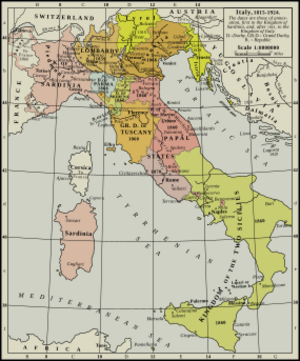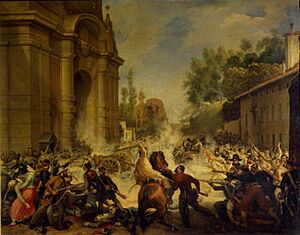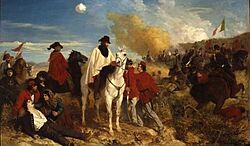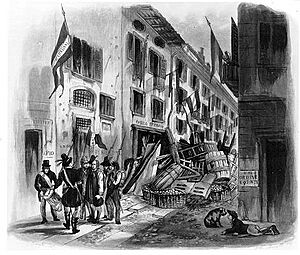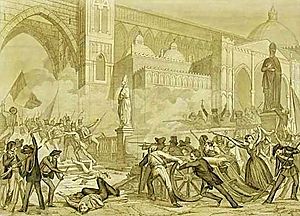Revolutions of 1848 in the Italian states facts for kids
Quick facts for kids Revolutions of 1848 in the Italian states |
|||||||||
|---|---|---|---|---|---|---|---|---|---|
| Part of the Revolutions of 1848 and the First Italian War of Independence | |||||||||
 Episode from the Five Days of Milan, painting by Baldassare Verazzi |
|||||||||
|
|||||||||
| Belligerents | |||||||||
Supported by: |
|||||||||
| Commanders and leaders | |||||||||
The 1848 Revolutions in the Italian states were a series of uprisings across the Italian peninsula and Sicily. At this time, Italy was not a single country. It was divided into many smaller states. Many of these states, especially in the north, were controlled by the Austrian Empire.
People in these Italian states wanted more freedom and a government that listened to them. They also wanted to be independent from foreign rule, especially from Austria. These revolts were part of bigger Revolutions of 1848 happening all over Europe.
The Kingdom of Sardinia, led by King Charles Albert, played a big role in these revolutions. In some northern cities like Milan, people rose up. This forced the Austrian General Radetzky to pull his soldiers back to strong forts called the Quadrilateral.
King Charles Albert wanted to unite Italy. He even had the support of Pope Pius IX, who ruled the Papal States in central Italy. In March 1848, Charles Albert declared war on Austria. He attacked the Quadrilateral forts. However, he didn't have enough allies. The Austrian army was too strong for him.
Charles Albert's forces were defeated at the Battle of Custoza in July 1848. He signed a peace agreement and pulled his troops out of Lombardy. This meant Austria remained in control of a divided Italy for a while longer.
The Start of the Revolts
After seeing changes happening in Rome, people in other Italian states also wanted more freedom. The first revolt began on January 12 in Sicily. People there demanded their own government, separate from the mainland. King Ferdinand II tried to stop them.
But a full revolt broke out in Sicily. Another revolt also started in Salerno and Naples. These uprisings forced King Ferdinand and his army out of Sicily. He had to allow a temporary government to be set up. The ideas for a new constitution were very modern for that time.
On February 11, 1848, Leopold II of Tuscany also gave his people a new constitution. This was a big step towards more freedom. King Charles Albert of Sardinia and Pope Pius IX followed this example. However, only King Charles Albert kept his constitution after the fighting ended.
Even with these changes, many states were still under strict rule. People in Lombardy-Venetia, controlled by Austria, did not have these freedoms. The Austrian Empire made things harder for them with high taxes. They also had a large army of 100,000 soldiers to keep control.
The revolts in Sicily helped start uprisings in northern Italy. In Milan, part of Lombardy-Venetia, a major revolt known as the Five Days of Milan began. This forced about 20,000 Austrian troops, led by General Radetzky, to leave the city.
General Radetzky had to pull his troops completely out of Milan and Venice. But he was smart and kept control of the strong Quadrilateral forts. These forts were in Verona, Peschiera, Legnago, and Mantua. He moved his soldiers into these key locations.
Italian rebels were encouraged when they heard that Prince Metternich, a powerful Austrian leader, had resigned. But they couldn't completely push Radetzky's troops out of the forts.
General Radetzky and his men in the Quadrilateral forts planned to fight back. But King Charles Albert attacked them first. He led the main attack against the forts. He had 25,000 extra soldiers helping him.
On his way to the forts, Charles Albert gained support from other leaders. Leopold II, Grand Duke of Tuscany sent 8,000 soldiers. Pope Pius sent 10,000, and Ferdinand II sent 16,050 men. They attacked the forts. On May 3, 1848, they won the Battle of Goito and captured the Peschiera fortress.
At this point, Pope Pius IX became worried about fighting the Austrian Empire. He pulled his troops out, saying he couldn't support a war between two Catholic nations. King Ferdinand of the Two Sicilies also called his soldiers back.
However, some soldiers did not obey the order. They continued fighting under Generals Pepe, Durando, and Giovanni. But they were defeated at the Battle of Custoza. A ceasefire was agreed upon. Radetzky regained control of almost all of Lombardy-Venetia, except for Venice. In Venice, the Republic of San Marco was declared, led by Daniele Manin.
A year later, Charles Albert attacked again. But he didn't have enough troops and was defeated at the Battle of Novara.
In the Duchy of Modena and Reggio, Duke Francis V tried to stop the revolts with his army. But when volunteers from Bologna came to help the rebels, he left the city to avoid bloodshed. He promised a constitution and forgiveness for the rebels. On March 21, 1848, he left for Bolzano. A temporary government was then set up in Modena.
What Happened Next
Even though Pope Pius had left the war, many of his people still fought with Charles Albert. The people of Rome rebelled against the Pope's government. They killed Pellegrino Rossi, one of the Pope's ministers. Pope Pius IX then fled to the fortress of Gaeta. He was protected there by King Ferdinand II.
In February 1849, Leopold II of Tuscany also had to flee to Gaeta because of another uprising. Piedmont was also defeated by the Austrians in 1849. Charles Albert had to give up his throne. His son, Victor Emmanuel II, became the new ruler.
In Rome, a new government took over. They passed laws to remove unfair taxes and create jobs for people. Giuseppe Garibaldi and Giuseppe Mazzini worked to build a "Rome of the People." They declared the short-lived Roman Republic.
The republic wanted to inspire people to create an independent Italian nation. It tried to help poor farmers by giving them some of the Church's large land. It also made changes to prisons and mental hospitals. They allowed freedom of the press and provided education that wasn't controlled by the Church.
However, the many changes and lower taxes caused money problems for the republic. They printed more money, which made prices go up very quickly. This hurt the republic's economy. Also, sending troops to help Piedmont against Austria left Rome open to attack.
Pope Pius asked Louis Napoleon, the French President, for help. Louis Napoleon saw this as a chance to gain support from Catholics. The French army arrived by sea, led by General Charles Oudinot. Even though Garibaldi won an early battle, the French, with Austrian help, eventually defeated the Roman Republic. On July 12, 1849, Pope Pius IX was brought back to Rome. He ruled under French protection until 1870.
The Italian Flag: A Symbol of Freedom
The Italian tricolour flag became a powerful symbol during the 1848 revolutions. During the Five Days of Milan in March 1848, the city was temporarily freed from Austrian rule. Many Italian flags and tricolour badges were seen everywhere.
On March 20, during fierce fighting, two patriots, Luigi Torelli and Scipione Bagaggia, climbed onto the roof of the Milan Cathedral. They raised the Italian flag on the highest spire, where the Madonnina statue stands. When the flag appeared, the crowd below cheered loudly. This historic flag is now kept in the Museum of the Risorgimento in Milan.
Another patriot, Luciano Manara, managed to raise the Italian flag on top of Porta Tosa, even with Austrian cannons firing. When Austrian troops left the city on March 22, a temporary government was set up. Its leader, Gabrio Casati, made a statement:
Let's get it over with once with any foreign domination in Italy. Embrace this tricolour flag that flies over the country for your valour and swear never to let it tear again.
This moment truly made the Italian flag a national symbol.
The next day, King Charles Albert of Piedmont-Sardinia promised the Milan government that his troops would use the Italian tricolour flag in the war. His flag would have the Savoy family's coat of arms on the white stripe. He said:
"In order to show more clearly with exterior signs the commitment to Italian unification, we want that Our troops ... have the Savoy shield placed on the Italian tricolour flag.
The coat of arms was red with a white cross. To make it stand out on the white stripe of the flag, it had a thin blue outline. This blue was the color of the Savoy family.
When Giuseppe Garibaldi returned to Italy from South America, he had a makeshift Italian flag on his ship. Patriots in port of Genoa welcomed him. They gave Anita Garibaldi, his wife, an Italian flag to give to him. They wanted him to plant it on Italian soil.
The Grand Duchy of Tuscany also adopted the Italian tricolour flag. At first, they kept their old flag. But later, they allowed their soldiers to wear an Italian tricolour scarf. Eventually, the Grand Duke adopted the Italian tricolour as the state flag and military flag. The Duchy of Parma and Piacenza and the Duchy of Modena and Reggio did similar things.
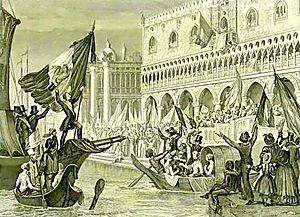
The flag of the Kingdom of the Two Sicilies was changed by King Ferdinand II. He added a red and green border to it. This flag was used from April 1848 to May 1849. The temporary government of Sicily, during the Sicilian revolution of 1848, used the Italian tricolour. Their flag had a special symbol called the trinacria, or triskelion, on it.
The Republic of San Marco, which declared independence from Austria in 1848, also used the Italian tricolour. Their flags showed their desire for Italian independence. One version was just the plain tricolour. Another had the winged lion of St. Mark, a symbol from the old Republic of Venice, on a white square.
A person who saw the end of the Republic of San Marco in August 1849 wrote:
The tricolour flags waved above every work, in every danger, and because the enemy balls not only tore up the silk, but broke the stick, it was immediately found who at great risk was going to replace another.
The Italian tricolour flag from 1848 that celebrated the Austrians leaving Venice is now in the Museum of the Risorgimento.

In 1849, the Roman Republic was formed after a revolt against the Papal State. They adopted a green, white, and red flag. It had a Roman eagle at the top of the flagpole. This flag lasted for four months. The Roman Republic fought until July 4, 1849, when the French Army defeated it. The secretary of the republican assembly, Quirico Filopanti, surrendered wearing an Italian tricolour scarf.
The Italian tricolour flag also flew over the barricades during the Ten Days of Brescia. This was a revolt by the people of Brescia against the Austrian Empire. It was also seen in many other cities like Varese, Gallarate, Como, Melegnano, Cremona, Monza, Udine, Trento, Verona, Rovigo, Vicenza, Belluno, and Padua.
This wide use of the flag across Italy showed that the Italian tricolour had become a strong symbol for the whole country. The flag's image started to appear not just on flags and military items, but also on everyday things like scarves and clothes.
See also
- Revolutions of 1848
- Revolt of Genoa
- Unification of Italy
- Bourgeois revolution
- Revolutionary Spring: Fighting for a New World 1848–1849 by Christopher Clark


